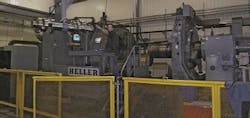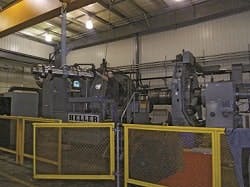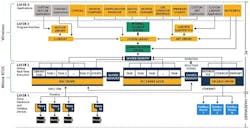Mike Joyce is I²T's vice president of engineering.
Using a PC for a machine motion controller offers the advantage of leveraging state-of-the-art processing capabilities at competitive prices. But, when the PC uses the Windows operating system (OS) there are issues.
By itself, the PC platform with a Windows OS has limitations in its control of time-critical processes. Windows is not deterministic. Without determinism, there's no guarantee that the system will respond to stimuli in exactly the same way during each machine cycle, and as a result the machine will not perform reliably.
SEE ALSO: Should We Switch to PC-Based Control?
Next-Gen Controls
That's the issue system integrator Integrated Industrial Technologies (I²T) of Pittsburgh faced with the design of its PC-based control system. With its software and industry expertise, I²T, has developed intuitive upgrades for many industrial applications, including milling, grinding and gantry robots.
Its new control system design was to be based around an industrial PC as a drop-in replacement into an existing HMI panel cutout. Intuitive user interfaces built on the Windows platform would eliminate the costly need to retrain operators. System changeover time was to be minimal, and I²T's customers' existing drive and motor investments had to be preserved.
I²T has a long history with PLC, CNC, HMI and proprietary control systems. Our breadth of experience has exposed us to a wide range of devices with hardware incompatibilities, communication differences and other factors that make it challenging to deliver a system that doesn't feel thrown together. This is especially true on retrofit solutions when the customer desires to keep some and replace other components on the machine.
We began using early versions of PC-based control systems in a similar fashion as any other controller. It became apparent how much easier it was to integrate other systems into the PC. The architecture of the PC provides many customization options. One can install software packages, add cards and communicate with external devices (USB/Ethernet) very easily. Communicating to a camera could be as simple as opening an Ethernet socket. Exchanging I/O with a legacy PLC could be accomplished by adding a PCI card to the motherboard. All of the development could center on the PC box. By using the PC solution, I²T engineers can divide the development efforts into manageable subsystems and use their software expertise to merge them into a final solution.
Benefits of COTS
A major benefit of development on the PC is the ability to use commercial off-the-shelf (COTS) technologies. The user interfaces can be developed in modern, commercially available environments such as Microsoft's Visual Studio. No longer are integrators restricted to working with proprietary software tools written by programmers, who might be excellent at motion control, but are not proficient at development tool design. I²T's user interface packages can take advantage of modern programming practices and features, such as databases, web and animations, years ahead of when they would appear in a proprietary HMI. As new development technologies emerged, I²T was able to transition its core knowledge and take advantage of the latest and greatest features, including C++ to C# and MFC to WPF.
Customer Upgrade
One of I²T's retrofit customers, Atlas Industries in Fremont, Ohio, is a producer of crankshafts that are precision machined from castings, forgings and billets with overall lengths up to 240 inches. Atlas had used proprietary controllers in its milling machines, which were nearing the end of their useful lives and had become costly to maintain. The upgrade control system that Atlas would turn to — based on I²T's approach — needed to insure that real-time control functions were supported while a new PC-based operator interface was added.
Atlas Industries' 240 in. crankshaft milling machine was retrofitted with a new control system and HMI. The software platform solution added new features without requiring operator retraining and it preserved Atlas' servo drive/motor investment.
Source: Atlas
Atlas wanted to upgrade its machines to use a common control platform with an operator interface that is easy to use and consistent between its machines, explains Jim Clark, Atlas Industries' vice president. "The machines we employed used proprietary CNC-based control systems from the original manufacturer. These older systems were limited in functionality and hard to maintain,” he says. "It was often very difficult to acquire spare parts for them. However, the hardware bases and mechanical components were in excellent — or at least salvageable — shape. We wanted to modernize our fleet of milling machines to increase the machine capabilities and reduce their maintenance costs."
Atlas and I²T had worked on several PLC or HMI-only projects in the past. "We've been working with them for more than 10 years and have had excellent results,” Clark says. "Other integrators don't have the product knowledge that I²T has. They're good at holding our hand and making product changes when we need them, and they can diagnose problems and fix them remotely from their offices in Pittsburgh."
SEE ALSO: PC-Based Controls Choice Still Evolving
In early discussions, it was determined that if any errors were made by Atlas when entering part data in the plant, it would cause scrapped parts and lost time. A more intuitive and error-proof user interface was required. Additionally, Atlas wanted more powerful diagnostics and data logging within the application to assist maintenance personnel when troubleshooting the equipment. When Atlas asked I²T for a recommendation, we realized that a solution based on the A3200 controller from Aerotech with a custom interface was the ideal solution.
Using Aerotech's A3200 real-time motion controller in the PC gave I²T a core to build everything else around. The real-time engine embedded in the Aerotech software ensured that the final package was still able to generate deterministic, precise motion.
I²T worked with the Atlas rebuild department to design an HMI specific to the production needs of their plant. "Several machines were upgraded in this manner," Stein reports. "Though the machines were similar in functionality and milling crankshafts, their mechanical features were quite different. They ranged from three to six axes of control, had vastly different I/O counts, and even differed in the sequence of operations performed. A custom user interface allowed I²T to tailor the machines' operation in a way that minimized the differences. Controls, status, colors and messaging all were made consistent across machines that originally provided extremely different user experiences."
The control software architecture isolates Windows and real-time applications to provide full Windows functionality while ensuring determinism in control operations. The interfaces to design, diagnose, optimize and setup a motion control application run under Windows, while the resultant control code and the machine interfaces run in an RTOS for Windows.
Source: Aerotech
Software Considerations
In order to leverage the performance and flexibility of the PC platform in control applications without compromising the ability to run the huge base of PC-compatible software without modification, a software solution was needed that enabled real-time task processing to coexist alongside the Windows application environment. I²T's relationship with Aerotech provided the solution. In some of its motion products, Aerotech leverages the PC software platform as the main computing engine with system integrators often tailoring the hardware configuration to meet the specific needs of each customer.
I²T specializes in integration of motion control systems. We customize the control process and user interface of a project. From our experiences in previous projects, we've developed a core set of algorithms, processes and libraries that we use as proven, base functionality. We then extend the features of these components based on the specific needs of a customer.
In the case of the Atlas milling machines, I²T applied its libraries to generate the profiles of the crank pins Atlas makes. These routines were based on our history in camshaft lobe grinding machines. The new geometry of the ring-milling machines required the math to be altered because the milling tool edge is on the inner diameter of a ring, and a grind process uses the outer diameter of the grinding wheel. Additionally, the lobes shape is centered on the rotation of the part, where the crank pin shapes are offset from center. This new mathematical relationship was customized to fit our existing routines that tightly coordinate the motion of an infeed and work rotation axis to generate the desired shape. Also, a new feature was created to allow "roundness compensation" to alter the shape in software for the compensation of mechanical limitations, and improve tolerance quality. In this case, I²T developed a new screen that would allow the operators to apply offsets to the milling mathematics around the target shape every five degrees. The data was presented in a table and with a plot showing the offset vs. ideal, so the operator could see exactly where the changes were being applied.
The RTOS Answer
When Aerotech developed its A3200 Digital Automation Platform, it knew that the optimal solution would support inclusion of a real-time operating system (RTOS) for real-time tasks to communicate directly with I/O devices without involving Windows' tasking mechanism.
After a search of available RTOSes, Aerotech selected INtime for Windows by TenAsys.
SEE ALSO: Reader Feedback: Automation Engineering and PC-Based Controls
"Windows' standard task scheduler optimizes for processor usage, and has no way of preventing housekeeping functions from disrupting the processing of time-critical tasks," explains Chris Grujon, TenAsys' marketing director. "Windows takes control of all the I/O resources of the processor at power-on, making any I/O devices compete with other system hardware, such as disk drives, timers, etc., for CPU cycles. INtime for Windows uses a technique called 'embedded virtualization' to partition the platform with its I/O resources. Windows is then restricted from controlling the I/O devices that are required by the INtime RTOS, which ensures deterministic access to I/Os dedicated for control. This is accomplished without requiring any modifications to Windows or Windows applications."
Joe Profeta, Aerotech's director of control systems, adds, "INtime is very solid and is more hardware-independent than others we've used. This hardware independence means Aerotech's customers can select almost any PC on which to run the A3200 controller, from minimal platforms with minimal memory to higher-end PCs with multiple cores for larger applications."
In the A3200, Windows runs the motion-programming environment and the data-acquisition software, while INtime supports all the real-time motion-control functions. "Partitioning applications have made our customers feel more comfortable," Profeta continues. "They trust that their time-critical processing won't be affected by Windows tasks. And, since customers are beginning to standardize around Windows' 64-bit platform, INtime also fulfilled our need for 64-bit processing on the Windows side, and provides built-in support for partitioning tasks onto multi-core processors, a capability that Aerotech intends to offer in the near future."
Profeta says Aerotech's customers and integrators will write programs that interact with the company's motion controllers using a full range of languages that include G-code, Aerobasic, Ladder diagrams, Structured Text, Function Block Diagrams, Matlab, LabView, C/C++ and .NET (C#, VB.NET) that the company provides. "We provide tools that allow users to program the controllers and set up services and tune the system,” Profeta adds. "We also provide a basic machine tool operator's interface. Approximately 50% of customers use Aerotech's Operator Interface. Others build their own interfaces using one of the libraries that Aerotech provides."
By using a Windows-based solution, we could use common development tools to create a rich user experience that can be customized to each solution we provide. With the A3200 software environment, the motion control application has access to all of the computer's resources allowing the control software to tightly integrate with file access, databases, communication networks or any other peripheral that is installed into the PC.
"We had a learning curve, but the screens that I²T provided were very user-friendly," Stein says. "Because we had input into the process of designing the screens, we knew that they would do what we want, and using them would also make our troubleshooting more efficient."
Another advantage inherent in PC-based solutions is the ability to gain access to additional motion programs that are available on the same system. For example, it's possible to dump raw calculation data from an application to a CSV file, and open it in Microsoft Excel for a quick analysis of the information. Companion applications, provided by Aerotech or the other component vendors can be used during development and diagnosis to perform data capture, examine parameters or alter performance of the machine. Networking allows for archiving data to a factory's server. And remote desktop tools allow integrators such as I²T to assist the customers over the Internet, saving lengthy and expensive travel. All of these Windows tools can be CPU intensive, but because the INtime RTOS runs the motion separately from Windows applications, they do not cause a degradation of performance of the machine.
Real-Time Results
"The A3200 real time engines in our updated machines manage the sub-millisecond coordination of two linked rotation axes and an infeed axis against a virtual master to perform constant surface-speed milling on an off-center crank pin as it is rotated," Stein says. "The real time engines also perform system fault monitoring and I/O control (spindle, lube, clamps)." At the same time, Stein adds, the application manages PC hard drive access (part data, logging) user interaction and, in some cases, Ethernet communications for remote diagnostics, all without adversely affecting the motion profile.
"In the past, when we had a glitch, we experienced machine downtime while the problem was resolved,” Stein explains. "Now with the new controls, we have reduced overall downtime with better diagnostics and can get solutions directly from I²T with remote analysis if necessary."
Profeta says this was made possible economically with a single computing platform due to the A3200's ability to run on the INtime RTOS and Windows at the same time. The PC platform enables significant reductions in the production cost of a high quality machine tool, while increasing throughput and quality, helping Atlas Industries compete in the global marketplace.
About the Author
Mike Joyce
Integrated Industrial Technologies

Leaders relevant to this article:


